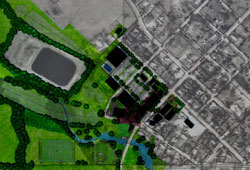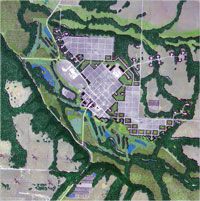| |
Revitalizing Stella, Missouri—A Sustainability Model
Podcasts
Listen to or download the podcast to learn more about how NRMRL research helps to support the protection of human health and the environment.
|
The small town of Stella, Missouri (population 187), is a unique living laboratory that is testing the sustainable development potential of similar communities, based on a planning model developed by EPA researchers in cooperation with local residents. The Stella master plan provides a baseline of environmental, economic, and social variables by which to evaluate the sustainability of Stella’s development over the next decade.
Background
The term “sustainability” is now part of the global vocabulary, with a dizzying variety of vague, feel-good associations. However, for EPA, sustainability is an action word that drives the science behind effective decision making—whether in the social, economic, or environmental realms of human activity. Sustainability scientists are normally limited to computer modeling of long-term decision-making effects. However, in the Missouri town of Stella, a three-hour drive from Kansas City, National Risk Management Research Laboratory (NRMRL) sustainability scientists are collaborating with residents in a real-world experiment with the potential to revitalize the community while learning about the effects of human decision making on natural resources.
 Stella began its association with EPA in 2006 during the demolition and disposal of an asbestos-laden former hospital building. Under the guidance of EPA’s brownfields program, which encourages development of restored urban properties, residents began studying plans to construct a mixed-use clinic, library, and housing complex on the old site. This was a defining moment for Stella, which, like many small towns, had seen a steady decline in its fortunes. Once a community of 500 to 600 people, Stella was noted for its showy dogwood trees that attracted visitors during an annual spring “Dogwood Tour.” The town was bordered by streams and forest lands, and had an active central shopping area. Over the years, the dogwoods died off, local streams deteriorated through neglect and upstream diversion, and jobs and population flowed outward. Even the teachers in Stella’s local school lived elsewhere. Stella gradually became more village than town while nearby communities, including Bentonville, Arkansas, Wal-Mart world headquarters, exerted development pressures within the region.
In 2006, spurred by the potential development of the restored hospital site, Stella residents accepted an invitation from EPA sustainability researchers to make a comprehensive study of the community and its sustainable future. This study resulted in a master plan that showed how the community could develop to meet citizens’ needs and respect their values, while strengthening the natural, social, and economic systems that make a community viable. The plan was adopted in June 2007.
The Master Plan
Sustainability theory may make use of scientific models dealing with climate warming, water resources, air quality, and land use, but in simpler terms, the success of Stella’s revitalization plan is conditioned upon (1) economic activities that factor in human and environmental costs; (2) social activities that ensure human safety, communal decision making, and shared access to natural resources; and (3) environmental actions that preserve “intact” ecosystems. Some proposed action items in Stella’s master plan that follow these guidelines include:
Economic Actions
- Concentrating commercial, institutional, and public activities in a core area within walking distance from a common parking area
- Creating a resident cooperative to support and pay local farmers to grow food to meet local needs, and create a farmers’ market
- Constructing a multi-purpose building to replace the demolished hospital structure in order to house a town hall, library, post office, café, and emergency shelter
- Converting a former general store to provide a café, shops, and commercial space
- Providing local auto parts services and a gas station
- Developing activities and opportunities to buy locally in order to keep money in the community
Social Actions
- Developing clustered housing around communal green space where children can play safely isolated from streets and within view of neighbors
- Providing walkable streets: multiple routes, shade trees, and sidewalks to increase human interaction
- Narrowing streets to reduce paved surfaces and related storm water runoff damage
- Creating parks and waterside activities for residents and visitors
Environmental Actions
- Developing a forested green belt around the community with a riparian (streamside) corridor
- Restoring the stream bank with native species
- Creating ponds for storm water retention and rain gardens on residential property to reduce water runoff
- Constructing wetlands to purify wastewater
- Recycling “grey water” for irrigation, lawn use, and car washing
The Stella master plan outlined a number of start-up projects selected for their reasonable cost, interest for community volunteers, and potential for sustainability. Some of these are already in progress. A sampling:
Community Project 1
Create four gateway gardens located at the major entry roads into Stella. Goal: To beautify the community and extend a welcoming outreach to visitors. The project involves interacting with the state of Missouri for permission to plant the gardens, selecting indigenous plants to blend with changing seasons, and planting and maintaining the gardens. Status: In progress.
Community Project 2
Restore dogwood trees throughout the community. Goal: To place Stella back on the regional Dogwood Tour to attract visitors. The project involves obtaining the permission of property owners at each location and recruiting help with the purchase, planting, and long-term care of trees. Status: In progress.
Community Project 3
Create a streamside park. Goal: To provide a waterside setting for community activities and a play area for children. The project involves developing a plan, applying for a grant, and enlisting volunteers to help clear and plant the area, and build play equipment. Status: In progress.
Community Project 4
Build a new veterans’ memorial. Goal: To honor area veterans with a memorial to be completed by November 1, 2008. The project involves planning, researching veterans’ names and donors, planting tree-lined walkways paved with bricks engraved with names of veterans, and coordinating volunteer maintenance. Status: On schedule for completion date.
Community Project 6
Organize a local farmers’ market. Goal: To compensate for the lack of a grocery store in town and to create interaction with area farmers. The project involves organizing a cooperative to contract with farmers to grow food for local consumers, creating a distribution network, advertising, and developing space for market tables and tents. Status: In progress.
Looking Ahead
Although development to meet Stella’s sustainability master plan will likely be slow and uncertain over the next decade, the process has revealed strong relationships among communities, developers, and environmental stewards. Indeed, it is not possible to separate the three systems: community concerns are developer and environmental concerns, developer concerns are community and environmental concerns, and environmental concerns are developer and community concerns. In terms of sustainability, everything matters—a concept that potentially applies to larger-scale urban and regional planning, as well as to small communities like Stella.
The uniqueness of the Stella project has been recognized by the National Building Museum in Washington, D.C., which will display information about Stella’s sustainability planning in a special “Green Community” exhibit beginning this October. The exhibit will run through October 2009 to demonstrate that green communities are not just a collection of sustainably designed buildings, but depend on the integration of many elements. Meanwhile, applying Stella’s strategy for sustainability is providing a field test for the study of human-made and natural relationships, truly unique in environmental research.
Visit the Stella Project  for more information. At user name, type Sustainable; at password, type Plan4it. for more information. At user name, type Sustainable; at password, type Plan4it.
Contact
Cindy Kirchmer, NRMRL Office of Public Affairs (513) 569-7966

New Publications
Al-Abed, S.R., G. Jegadeesan, J. Purandare, and D. Allen. (2008). “Leaching Behavior of Mineral Processing Waste: Comparison of Batch and Column Investigations.” Edited by Choi, Fingas, Gardea-Torresdey, Lyberatos, and Tay. Journal of Hazardous Materials  Elsevier BV, Amsterdam, Netherlands, 153, 3: 1088–1092. Elsevier BV, Amsterdam, Netherlands, 153, 3: 1088–1092.
Choi, H., S.R. Al-Abed, S. Agarwal, and D.D. Dionysiou. (2008). “Synthesis of Reactive Nano-Fe/Pd Bimetallic System-Impregnated Activated Carbon for the Simultaneous Adsorption and Dechlorination of PCBs.” Edited by L.V. Interrante. 10.1021/cm8003613. Chemistry of Materials  American Chemical Society, Washington, DC, 20, 11: 3649–3655. American Chemical Society, Washington, DC, 20, 11: 3649–3655.
Hauschild, M., D. Medearis, and A.M. Vega. (2007). “The U.S.-German Bilateral Working Group: Collaborative Engineering and Scientific Research for a Sustainable Future. Results from Phase 3 (2000–2005) and Beginning Phase 4 (2006–2010).” In: Proceedings, Revit and Cabernet 2007, 2nd International Conference on Managing Urban Land  (Please scroll to the bottom of the Web page to find the proceedings for this event.) Stuttgart, Germany, April 25–27. (Please scroll to the bottom of the Web page to find the proceedings for this event.) Stuttgart, Germany, April 25–27.
Vallabhaneni, S., F. Lai, C. Chan, E.H. Burgess, and R.I. Field. (2008). “SSOAP – A USEPA Toolbox for SSO Analysis and Control Planning.” In: Proceedings, EWRI 2008 World Environmental and Water Resources Congress  , Honolulu, HI, May 13–16. , Honolulu, HI, May 13–16.
EPA Reports
Assessing Arsenic Removal by Metal (Hydr)Oxide Adsorptive Media Using Rapid Small-Scale Column Tests (PDF) (62 pp, 938 KB) (EPA/600/R-08/051) April 2008
Watershed Management Tool for Selection and Spatial Allocation of Nonpoint Source Pollution Control Practices (PDF) (104 pp, 1.77 MB) (EPA/600/R-08/036) January 2007
You will need Adobe Reader to view some of the files on this page.
See EPA's PDF page to learn more. |
 Research Highlights
Research Highlights
![[logo] US EPA](https://webarchive.library.unt.edu/eot2008/20090508165922im_/http://www.epa.gov/epafiles/images/logo_epaseal.gif)
